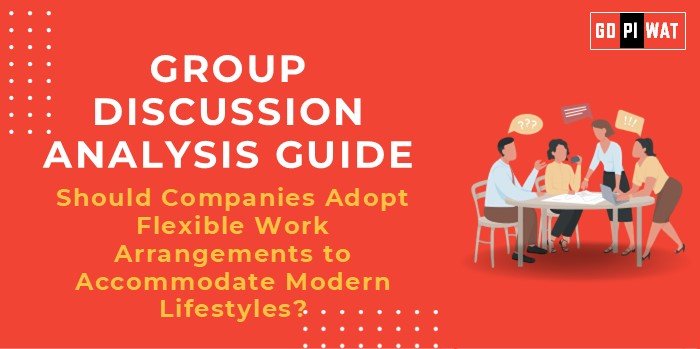📋 Group Discussion Analysis Guide: Should Companies Adopt Flexible Work Arrangements to Accommodate Modern Lifestyles?
🌐 Introduction to the Topic
Opening Context: As work dynamics evolve globally, flexible work arrangements—such as remote work, flexible hours, and hybrid models—have gained prominence, especially after the COVID-19 pandemic reshaped workplace norms.
Topic Background: Flexible work arrangements address the changing needs of employees and employers alike, blending work-life balance with productivity. Prominent companies like Google, Microsoft, and TCS have adopted hybrid models, fueling discussions on the long-term viability and advantages of flexible work setups.
📊 Quick Facts and Key Statistics
• 💼 Employee Preference: 78% of employees say flexible work improves work-life balance (McKinsey, 2023).
• 📈 Productivity Metrics: Companies adopting flexible hours report a 13% rise in productivity (Stanford Research, 2023).
• 💰 Cost Savings: Companies save $11,000 annually per employee through remote work (Global Workplace Analytics, 2023).
🤝 Stakeholders and Their Roles
- 👩💻 Employees: Seek autonomy, improved work-life balance, and reduced commute time.
- 🏢 Employers: Benefit from cost savings, access to a broader talent pool, and increased retention.
- ⚖️ Government: Formulates labor laws to regulate flexible work and ensure employee rights.
- 💻 Tech Companies: Provide tools like Zoom, Slack, and Microsoft Teams to enable seamless virtual work.
🏆 Achievements and Challenges
✨ Achievements:
- 📊 Productivity Gains: Stanford study reports a 13% productivity rise in flexible work setups.
- 💵 Cost Reduction: Remote work reduces overhead costs for employers and saves commuting costs for employees.
- 🌎 Global Talent Pool: Companies access a diverse workforce unhindered by geographical boundaries.
- 💼 Improved Retention: Flexible work reduces burnout and attrition; 75% of employees prefer hybrid models (PwC, 2023).
⚠️ Challenges:
- 🤝 Collaboration Issues: Lack of face-to-face interactions may hinder teamwork and creativity.
- ⌚ Work-Life Imbalance: Flexible work often blurs personal and professional boundaries.
- 📉 Performance Monitoring: Employers struggle to monitor remote productivity effectively.
🌎 Global Comparisons:
- 🇺🇸 United States: Major firms like Amazon and Google offer hybrid models to retain top talent.
- 🇯🇵 Japan: Flexible hours are less common due to entrenched traditional work culture.
- 🇳🇱 Netherlands: Flexible work policies are legally protected, enhancing work-life balance.
🗣️ Structured Arguments for Discussion
Supporting Stance: “Flexible work arrangements improve employee satisfaction and productivity while lowering operational costs.”
Opposing Stance: “A lack of in-person collaboration in flexible setups can undermine creativity, culture, and accountability.”
Balanced Perspective: “Flexible work offers numerous advantages, but a hybrid model combining remote flexibility with in-person collaboration may provide the best solution.”
💡 Effective Discussion Approaches
- 📜 Opening Approaches:
- “Flexible work arrangements have boosted productivity by 13% globally while fostering work-life balance.”
- “While many employees benefit from remote setups, some challenges persist around collaboration and performance monitoring.”
- 🛠️ Counter-Argument Handling:
- Address concerns about collaboration by citing hybrid solutions.
- Acknowledge monitoring issues and propose tech-based solutions for performance measurement.
📈 Strategic Analysis of Strengths and Weaknesses
- 🏅 Strengths: Improved productivity, reduced costs, broader talent pool.
- ⚠️ Weaknesses: Collaboration gaps, blurred work-life boundaries, monitoring challenges.
- 💡 Opportunities: Hybrid models, tech innovations (AI in monitoring), employee wellness programs.
- ⚡ Threats: Over-reliance on technology, resistance to change, cybersecurity risks.
🎓 Connecting with B-School Applications
- 📚 Real-World Applications: Explore hybrid models for project themes in HR strategy, operations efficiency, and organizational behavior.
- 💬 Sample Interview Questions:
- “How can companies balance productivity and collaboration in flexible work setups?”
- “What role does technology play in enabling effective flexible work policies?”
- 🔑 Insights for B-School Students: Flexible work models are key in HR transformation, operational cost management, and leadership adaptation in evolving workplaces.


